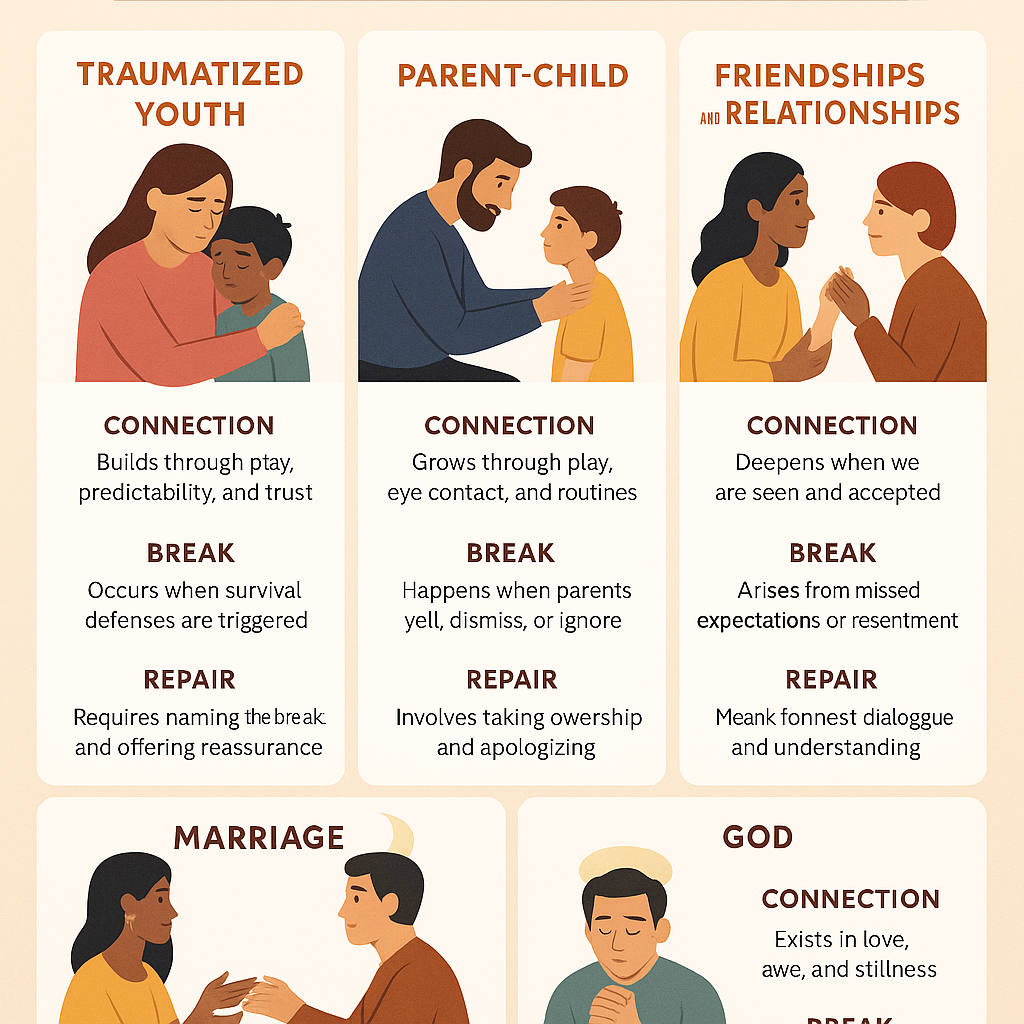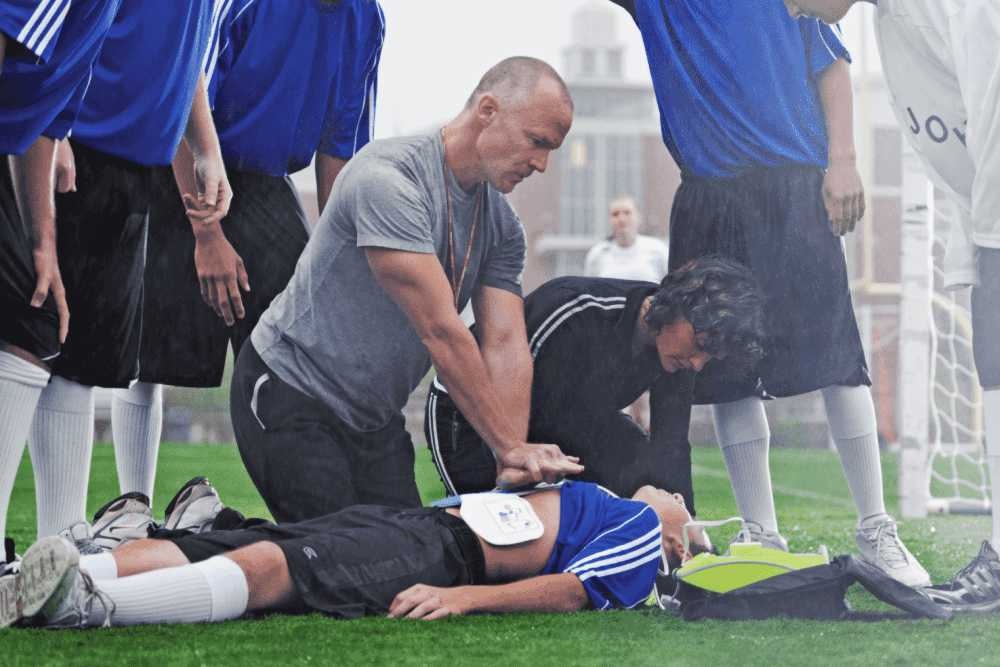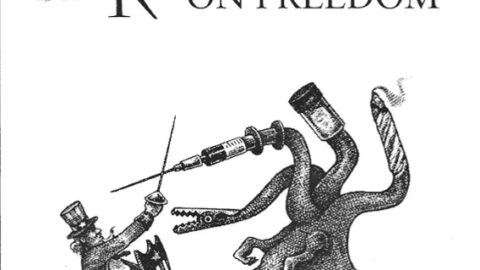In every relationship—whether with a child, a spouse, a friend, or even with God—there is an invisible pattern that determines whether the bond deepens or shatters. This pattern is connection, break, and repair. When we understand this cycle, we understand the architecture of love, trust, and resilience. When we ignore it, relationships fracture under the weight of silence, pride, or unresolved wounds.
Let us explore this sacred rhythm in five powerful areas of life:
1. Connection, Break, and Repair with Traumatized Youth
Connection:
Traumatized youth have often experienced repeated betrayal—by caregivers, systems, or society. Connection begins with safety, predictability, and consistent care. It means showing up without judgment, being attuned to emotional signals, and offering trust without demand.
Break:
Breaks come quickly with these youth. A raised voice, a forgotten promise, or a misunderstood tone can ignite survival defenses. But these are not manipulations—they are signals of a brain wired to expect harm.
Repair:
Repairing with traumatized youth involves naming the break, owning the adult’s role, and offering reassurance without defensiveness. “I saw you shut down when I raised my voice. I’m sorry. That must have felt scary.” This teaches the youth that relationships don’t have to end when things go wrong, and that safety can coexist with honesty. Over time, these experiences rewire the limbic system, softening the threat response and creating space for growth.
2. Connection, Break, and Repair in the Parent-Child Relationship
Connection:
Children connect through play, eye contact, soothing routines, and shared joy. Connection fills the emotional tank—it’s where trust is born.
Break:
No parent is perfect. Breaks happen when we yell, dismiss, ignore, or misread their needs. The danger is not the break itself—it’s the absence of repair.
Repair:
“I overreacted, and I’m sorry. I should have listened before I got angry.” These words are magic. Repair is not weakness—it’s leadership. It teaches children that mistakes are part of life, but healing is always possible. It invites children to repair too, rather than live in shame or silence. Parenting becomes not about being flawless, but about being authentic, humble, and human.
3. Connection, Break, and Repair in Adult Friendships and Relationships
Connection:
Deep adult friendships and relationships thrive on vulnerability, mutual respect, and shared values. Connection is formed when we are truly seen and still accepted.
Break:
Breaks emerge from missed expectations, unspoken resentments, or clashing values. Without courage to speak the truth in love, friendships can wither.
Repair:
Repair requires truth and tenderness. “I felt hurt when you didn’t check in, and I know life’s been full for you. Can we talk about it?” This opens a door. Real friendship doesn’t mean never breaking—it means repairing stronger than before. That’s what makes adult bonds rich and sacred.
4. Connection, Break, and Repair in Marriage
Connection:
Marriage begins with emotional resonance—being chosen, seen, and wanted. It’s fueled by intimacy, shared dreams, and daily affirmation.
Break:
Breaks are inevitable—neglect, criticism, contempt, emotional withdrawal. Unrepaired, these small fractures become wide chasms.
Repair:
Repair means turning toward instead of away. It involves humility: “I was defensive earlier. I think I was scared you didn’t believe in me.” It includes listening deeply, without solving. Repairing in marriage is not about keeping score, but about healing the space between us. A marriage that practices consistent repair becomes a refuge, not a battlefield.
5. Connection, Break, and Repair in Our Relationship with God
Connection:
God invites us into relationship through love, awe, and stillness. Whether in silence, Scripture, nature, or worship, connection with God centers us.
Break:
Breaks come when we feel abandoned in suffering, when prayers seem unheard, when shame or sin disconnects us from divine presence. Often, it is we who turn away—not God.
Repair:
Repair is possible every moment. It begins with honest lament: “Why have You forsaken me?” and continues with faithful return: “Create in me a clean heart, O God.” God never tires of repair. The Prodigal Son story shows a Father who runs, not to punish, but to restore. In this relationship, repair is always met with mercy.
Conclusion: The Courage to Repair
The cycle of connection, break, and repair is not a sign of relational dysfunction—it is the evidence of real, living relationships. Perfection is not required. What is required is the humility to recognize when a break has happened and the courage to initiate repair.
As trauma therapist Dr. Bruce Perry reminds us: “The most powerful buffer against the effects of trauma is a safe, nurturing relationship.”
And as Scripture affirms: “Love covers a multitude of sins.” (1 Peter 4:8)
In every area of life—trauma recovery, parenting, friendship, marriage, and faith—the sacred rhythm remains the same:
Connect. Break. Repair. Repeat.
This is how we grow. This is how we heal. This is how we love.





